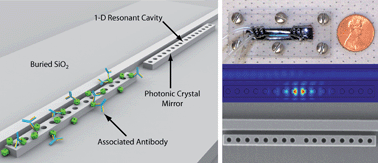A multiplexed optofluidic biomolecular sensor for low mass detection†
Abstract
Optical techniques have proven to be well suited for in situ biomolecular sensing because they enable high fidelity measurements in aqueous environments, are minimally affected by background solution pH or ionic strength, and facilitate label-free detection. Recently, there has been significant interest in developing new classes of optically resonant biosensors possessing very high quality-factors. This high quality-factor enables them to resolve the presence of very small amounts of bound mass and leads to very low limits of detection. A drawback of these devices is that the majority of the resonant electromagnetic energy is confined within the solid light-guiding structure thus limiting the degree to which it overlaps with the bound matter. This in turn lowers the ultimate device sensitivity, or the change in output signal in response to changes in bound mass. Here we present a novel optofluidic biosensor platform that incorporates a unique one-dimensional photonic crystal resonator array which enables significantly stronger light-matter interaction. We show here how this, coupled with the ability of planar photonic crystals to spatially localize the optical field to mode volumes on the order of a wavelength cubed, enables a limit of detection on the order of 63 ag total bound mass (estimated using a polyelectrolyte growth model) and a device sensitivity an order of magnitude better than similar devices. The multiplexing capabilities of our sensor are demonstrated by the individual and concurrent detection of interleukins 4, 6 and 8 using a sandwich assay.


 Please wait while we load your content...
Please wait while we load your content...